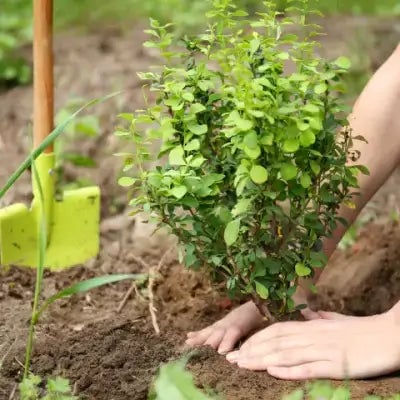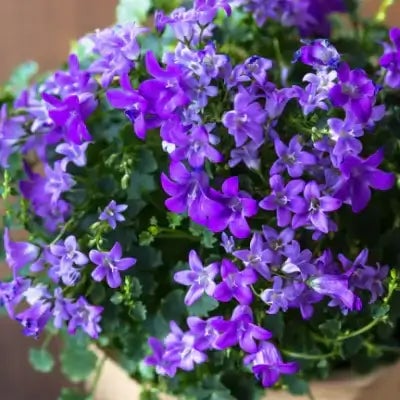8 Most Loved Easy Perennials
Are you a newbie gardener looking for plants that will make your garden look great without putting in too much effort? If so, these perennials are a perfect choice. Perennials come back year after year, meaning all those hours spent caring for them will be rewarded with lots of vibrant blooms and colorful foliage throughout the season and for many seasons as well to come. Plus, they require little maintenance compared to annuals; once they're established, most need an occasional watering or thinning out. So, if you're ready to plunge into gardening but need to know which plants to start with, check out this list of eight easy perennials for beginner gardeners!
Adam & Eve Orchid
Adam & Eve Orchid is a perennial, meaning it can grow year-round without replanting when they flower at approximately 0.5 inches in length. Their base turns violet as they age, creating a stunning color contrast. The Plant is easy to take care of. It thrives in partial or complete shade and various soil kinds. It is easy to integrate into any landscaping. Regularly water it. However, be careful not to overwater it or allow it to dry between waterings.

Virginia Bluebells
The Virginia Bluebell plant, Mertensia Virginica, is a shade-thriving plant that can be found growing near water. These perennials' beauties thrive in full shade and rich soil. The hardy planting zones are 3-9; they reproduce and make more plants by reseeding.When the roots of these plants are broken up or split in half, they can be planted to make other plants. It blooms in early spring, and the exact color depends on the PH levels of the soil. The colors range from lilac and lavender to purple or bright pink. This flower has a long lifespan and lives for over 20 years in shaded gardens.

Aruncus Plant
Aruncus perennial, a part of the Rose family, is indigenous to Japan and North America and, as a European cultivar, has existed since Roman times. The perennial Plant is found in meadows, ponds, waterways, or other moist spots. This Plant is dioecious. This means that the flowers are male or female on every Plant. Male plants show more flowers than female plants and are popular with clients. The Plant doesn't require any maintenance. The goat's beard must be positioned partially or entirely in the sun. It requires well-drained soil, which is moist. They can also be planted in loam, sand, and clay soil. They may require help to be placed in humid, hot areas. They require a reasonable amount of water daily.
Brown Eyed Susan
Many names, including Black-Eyed Susan, Brown Betty, Golden Jerusalem, and the Yellow Ox-eye Daisy, know it.They are low-maintenance, quickly grown, and flourish in almost every circumstance, making them an excellent option for beginners in the garden. The individual plants can reach an adult height of 2 to 5 feet throughout summer and spring. They will also provide a bounty of 1- to 2-inch flowers throughout the summer, right up to when the frosts begin.

Blue Violet
Blue violets are attractive wildflowers renowned for their purplish to blue-white shades. It is common throughout North America and is often referred to as an invasive plant. It is a popular plant for its ornamental value and is the state flower of several states of the US. The leaves and flowers are edible, making them safe to be planted near pets.Blue violets will benefit from slow-release fertilizer to begin the growing period in spring and then again in the latter part of summer to promote the autumn bloom. The water-soluble fertilizer is applied twice a week during this growing period. Common blue violet is well-suited to organic fertilizers as well.

Bishops Weed Ground Elder
It is known for its white-tinged blue-green foliage; the variegated bishop's Weed draws attention when it fills the shaded areas in any landscape. In the summer heat, this rigid, low-growing perennial produces beautiful white flowers that look like those that are part of Queen Anne's Lace.One of the many benefits of working with Variegated Bishop's Weed is that it needs almost zero maintenance and maintenance. It is generally thriving during dry seasons and shows minimal or no evidence of loss of leaves during minor drought-related periods. A prolonged loss of water can result in leaves becoming crisp or burning.

It is a grouping of plants that are around a foot in width. It is a great plant to put in flower beds to create borders or as a plant in window boxes or pots in which it cascades across the side. It's stunning in hanging baskets, in which it can cascade down. There is a misconception that blue lobelia doesn't flower in extreme heat. Still, certain varieties, like Magadi Blue, Magadi Blue with White Eye, and Lucia Dark Blue, can survive the heat. Blue lobelia can thrive when it is in the full sun, part shade, or full sun. It is renowned for its growing ability and requires frequent watering during hot weather.

Bloodroot
Blood Root, also known as Bloodwort puccoon Indian Red Paint, sang-dragons snakebite, as well as many more that are based on slight variations in the area. Bloodroot is located in the eastern part of North America and is the only species of its Genus. Are they the closest relatives? Snow poppies can be found only in China. They come in many different forms in their leaves and white, yellow-centered flowers, but the fruit is bright and scarlet, which is why it's called.Despite the lack of research on the efficacy of bloodroot, it is widely regarded as a promising homeopathic treatment for cancer. It's typically used to treat skin cancers which is a nod to its history of being utilized to treat skin ailments.
How to Create a DIY Perennial Bed for Beginners
Any beginner gardener who wants to add enduring and effortless beauty to their outdoor space will find building a do-it-yourself perennial bed fulfilling. Perennials live for multiple years, so planting a well-designed garden allows you to enjoy its beauty through numerous seasons without often needing to replace plants. Though plant options for a perennial bed are limitless, the same basic guidelines exist for making a healthy, lively garden. The following guide will help you establish a successful perennial garden that will suit your style without needing to focus on particular plant species.
1. The initial step when constructing a perennial bed requires choosing its location. Monitor how sunlight reaches different areas of your yard throughout the day to determine the amount of sun exposure they receive. Perennial plants differ in their sunlight needs because some require full sun exposure while others grow best in partial shade. It's vital to monitor soil moisture levels regularly. Local drainage conditions can make some areas more prone to drought or flooding. Finding a location that balances sunlight exposure with shade and proper drainage ensures your perennial garden will flourish over time.
2. Before digging begins, carefully visualize your bed's dimensions and overall design. Use paper sketches or essential garden planning software to develop your designs for planning purposes. Your landscape design choices can include softly curved forms that match your surroundings or rigid geometric shapes. The design you select requires careful consideration of how you will navigate the bed for maintenance activities like weeding and watering. Paths and stepping stones in more extensive beds make every area accessible while protecting sensitive plants.
3. Successful perennials require proper soil preparation, which is a key gardening practice. Begin preparing by clearing all plant life from your selected area. Your initial clearing should remove grass alongside weeds and any old plants that may be present. After removing all vegetation from the planting area, work to loosen the topsoil layer to a depth between 8 and 12 inches. Double-digging techniques or work with a garden fork to further improve drainage and break up soil clumps in compacted soil; improve soil quality by adding organic materials like compost or manure to enhance levels of nutrients and support beneficial microorganisms. A loamy and fertile environment will give your perennials the best possible start.
4. A perennial bed looks visually appealing when its design includes a mix of varying plant heights, textures, and bloom periods. Avoid specifying particular plant types, yet maintain a balanced mix of perennials with varying heights. Place the taller perennials towards the backside of your bed when it borders a wall or fence, and position them in the center when your garden receives views from every direction. Choose plants with various leaf shapes and textures to keep your garden visually interesting throughout the year. Strategically planning your garden bed to include plants blooming at different times promises a consistent display during the growing season.
5. When planting perennials, dig holes that match the depth and width of each plant's root ball. If the roots are pot-bound, gently untangle them before positioning the plant into the hole so that the crown aligns with ground level. Place soil around plant roots and gently compress it to remove potential air gaps. Immediately water the planting area to enable the soil to settle and provide your freshly planted additions with a solid beginning. Always follow spacing guidelines for plants because overcrowding causes resource competition and poor airflow, which leads to higher disease risks.
6. Once planting is completed, place organic mulch over the soil's surface to help maintain moisture and prevent weed growth. Mulch serves three purposes: maintaining moisture levels within the soil while controlling weed growth and stabilizing soil temperature. Soil structure benefits from organic mulch because it decomposes gradually. Maintain a small space between the soil and each plant base to ensure moisture does not accumulate on the stems.
7. Perennials need consistent moisture during establishment, although they generally require minimal maintenance. Consistent watering throughout the initial growing season leads to robust root growth. As time passes, many perennials develop the ability to handle less frequent watering, but extra care must be given during intense heat and drought periods. Regularly check soil moisture levels and adjust your watering schedule according to rainfall patterns and regional climate.
8. Your perennial bed requires additional maintenance beyond watering, which includes periodic fertilization combined with light pruning and deadheading spent flowers. These maintenance practices promote more substantial growth alongside the appearance of new flowers. Certain perennials need division every few years to stay healthy, while others can remain in their original spot for extended periods. If your perennials show signs of overcrowding, such as diminished flowering and discoloration, then splitting and replanting them helps sustain their health and vitality.
9. Developing your perennial garden requires patience and ongoing learning because it represents a continuous learning journey. Beginners should keep their spirits up even if their first gardening season doesn't meet expectations. Gardening involves learning through experiences where each obstacle teaches important lessons that lead to better gardening methods. Study your plants' growth patterns and adaptation to local conditions before modifying your maintenance routine. Through continuous practice, you will develop increased confidence in selecting appropriate plant combinations and maintaining your flourishing garden.
Creating a perennial bed that lasts years and brightens your outdoor space requires careful location selection, soil preparation, and thoughtful arrangement planning. Consistent gardening efforts through watering, weeding, and occasional pruning will enable you to grow a thriving garden that delivers aesthetic appeal and personal satisfaction.
Read more

Frequently Asked Questions (Trees For Sale Online Nursery)Every tree purchaser has the right to know what they are buying. We answer a few questions about our trees and online shopping for trees. U...

Planting methods are dynamic from one plant to the next. Read on for an insightful look at planting instructions for different plants. Planting Instructions For Bare root treeIt would be commendabl...


